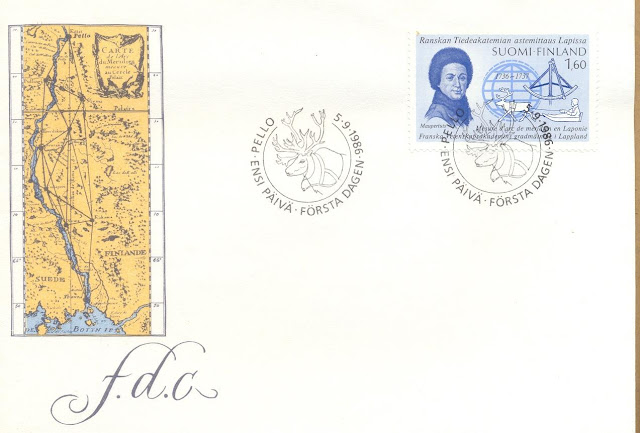 I’ll now tell you something about the FDC named Measurement of the Arctic Meridian in Lapland, which was given to me by Ella. In 1687 Isaac Newton wrote in his Principia that the Earth is flattened at the poles. Newton gave theoretical calculations for this. His argument caused a scientific dispute.
I’ll now tell you something about the FDC named Measurement of the Arctic Meridian in Lapland, which was given to me by Ella. In 1687 Isaac Newton wrote in his Principia that the Earth is flattened at the poles. Newton gave theoretical calculations for this. His argument caused a scientific dispute.
To prove the flattening of the Earth and to verify the theoretical calculations by Newton, the French Royal Academy of Sciences (Académie Royale de Sciences) sent two expeditions to measure the meridian at the equator and near the poles. One led by La Condamine was sent to Mitad del Mundo at that time in Peru, now in Ecuador and another, led by de Maupertuis, to the River Tornio valley. A participant in the latter expedition was also Anders Celsius, a famous Swedish physicist, who during his visit in Paris had proposed a measuring expedition to resolve the ongoing debate. The other participants were Clairaut, Camus, Le Monnier and abbot Outhier. A local participant was astronomer Anders Hellant (1717-1789) from Tornio (that time better known by the Swedish name Torneå).
A base line of 14.3 km was accurately measured on the ice-covered River Tornio and with use of that the length of the meridian degree was calculated by means of triangulation. The southernmost point of measurement was the tower of the Tornio Church and the northernmost point was the hill of Kittisvaara 4 km north of the village of Pello. A memorial was erected in 1956 on the hill. When Maupertuis returned he reported that one meridian degree is in Lapland 57,437.9 toises. (The ancient French unit of length toise was 1.949 meters.) This result when compared to the value of 57,060 toises near Paris proved that the Earth is flattened near the poles just as the theory predicts. Gross errors were later pointed out in the measurements but the conclusions were correct. The king of France rewarded Celsius with an annual pension of 1,000 livres. The results of the measurements were made public in Maupertuis's book "La Figure de la Terre" (Paris 1738). It was also published in English as "THE Figure of the Earth" (London 1738) and in Latin, Leipzig 1742. The academy correspondent, abbot Réginald Outhier published in 1744 in Paris an illustrated account of the journey "JOURNAL D’UN VOYAUGE AU NORD, En 1736. & 1737". Outhier's map.
The stamp on the FDC depicts the leader Maupertuis, the most important observation instrument called quadrant and a reindeer referring to Lapland, and of course our Earth with flattened poles. The map on the cover depicts the River Tornio Valley between Finland and Sweden and the measurement points. Pello was the most northern point, that’s why you can see the name Pello on the postmark. The French stamp also depicts the leader of the Ecuador expedition, Charles Marie de la Condamine. The stamp was a joint issue with France. Before this issue Finnish Post had issued joints only with other Nordic countries.
nice stamps! check out my cute panda stamps at:
ReplyDeletehttp://helixphilately.blogspot.com/